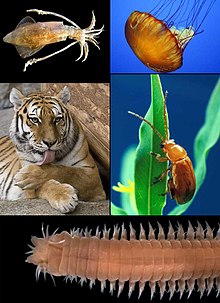
Back ParaHoxozoa AF نظائر حيوانات النحت Arabic ParaHoxozoa English ParaHoxozoa Spanish پیراهوکسوزوآ FA Parahoxozoa Hungarian ParaHoxozoa ID ParaHoxozoa Portuguese ParaHoxozoa SIMPLE ParaHoxozoa Serbian
| ParaHoxozoa | |
|---|---|

| |
| Kepelbagaian parahoksozoa | |
| Pengelasan saintifik | |
| Domain: | Eukaryota |
| Alam: | Haiwan |
| Subalam: | Eumetazoa |
| Klad: | ParaHoxozoa Ryan et al., 2010 |
| Taxa | |
ParaHoxozoa (atau Parahoxozoa) adalah klad haiwan yang terdiri daripada Bilateria, Placozoa, dan Cnidaria.[1] Hubungan klad ini berbanding dua garis keturunan haiwan yang lain, Ctenophora dan Porifera, masih diperdebatkan. Beberapa kajian filogenomik telah mengemukakan bukti yang menyokong Ctenophora sebagai saudara kepada Parahoxozoa dan Porifera sebagai kumpulan saudara kepada haiwan yang lain (contohnya, [2][3][4]). Kajian lain telah mengemukakan bukti yang menyokong Porifera sebagai saudara kepada Parahoxozoa dan Ctenophora sebagai kumpulan saudara kepada haiwan yang lain (contohnya, [5][6][7]). Mereka mendapati bahawa sistem saraf sama ada berkembang secara bebas dalam ctenophora dan parahoxozoa,[8] atau telah hilang secara sekunder dalam porifera.[9] Jika ctenophora dianggap sebagai yang pertama berpisah, Eumetazoa kadangkala digunakan sebagai sinonim untuk ParaHoxozoa.[10]
- ^ Ryan, Joseph F.; Pang, Kevin; Mullikin, James C.; Martindale, Mark Q.; Baxevanis, Andreas D. (2010-10-04). "The homeodomain complement of the ctenophore Mnemiopsis leidyi suggests that Ctenophora and Porifera diverged prior to the Parahoxozoa". EvoDevo. 1 (1): 9. doi:10.1186/2041-9139-1-9. ISSN 2041-9139. PMC 2959044. PMID 20920347.
- ^ Pick, K. S.; Philippe, H.; Schreiber, F.; Erpenbeck, D.; Jackson, D. J.; Wrede, P.; Wiens, M.; Alie, A.; Morgenstern, B.; Manuel, M.; Worheide, G. (2010). "Improved Phylogenomic Taxon Sampling Noticeably Affects Nonbilaterian Relationships". Molecular Biology and Evolution. 27 (9): 1983–1987. doi:10.1093/molbev/msq089. ISSN 0737-4038. PMC 2922619. PMID 20378579.
- ^ Feuda, Roberto; Dohrmann, Martin; Pett, Walker; Philippe, Hervé; Rota-Stabelli, Omar; Lartillot, Nicolas; Wörheide, Gert; Pisani, Davide (2017). "Improved Modeling of Compositional Heterogeneity Supports Sponges as Sister to All Other Animals". Current Biology. 6 (24): 3864–3870.e4. Bibcode:2017CBio...27E3864F. doi:10.1016/j.cub.2017.11.008. hdl:11572/302898. PMID 29199080.
- ^ Simion, Paul; Philippe, Hervé; Baurain, Denis; Jager, Muriel; Richter, Daniel J.; Franco, Arnaud Di; Roure, Béatrice; Satoh, Nori; Quéinnec, Éric (3 April 2017). "A Large and Consistent Phylogenomic Dataset Supports Sponges as the Sister Group to All Other Animals" (PDF). Current Biology (Submitted manuscript). 27 (7): 958–967. Bibcode:2017CBio...27..958S. doi:10.1016/j.cub.2017.02.031. ISSN 0960-9822. PMID 28318975. S2CID 4560353.
- ^ Whelan, Nathan V.; Kocot, Kevin M.; Moroz, Leonid L.; Halanych, Kenneth M. (2015). "Error, signal, and the placement of Ctenophora sister to all other animals". Proceedings of the National Academy of Sciences. 112 (18): 5773–5778. Bibcode:2015PNAS..112.5773W. doi:10.1073/pnas.1503453112. ISSN 0027-8424. PMC 4426464. PMID 25902535.
- ^ Borowiec, Marek L.; Lee, Ernest K.; Chiu, Joanna C.; Plachetzki, David C. (2015). "Extracting phylogenetic signal and accounting for bias in whole-genome data sets supports the Ctenophora as sister to remaining Metazoa". BMC Genomics. 16 (1): 987. doi:10.1186/s12864-015-2146-4. ISSN 1471-2164. PMC 4657218. PMID 26596625.
- ^ Whelan, Nathan V.; Kocot, Kevin M.; Moroz, Tatiana P.; Mukherjee, Krishanu; Williams, Peter; Paulay, Gustav; Moroz, Leonid L.; Halanych, Kenneth M. (2017). "Ctenophore relationships and their placement as the sister group to all other animals". Nature Ecology & Evolution. 1 (11): 1737–1746. Bibcode:2017NatEE...1.1737W. doi:10.1038/s41559-017-0331-3. ISSN 2397-334X. PMC 5664179. PMID 28993654.
- ^ Moroz, Leonid L.; Kocot, Kevin M.; Citarella, Mathew R.; Dosung, Sohn; Norekian, Tigran P.; Povolotskaya, Inna S.; Grigorenko, Anastasia P.; Dailey, Christopher; Berezikov, Eugene; Buckley, Katherine M.; Ptitsyn, Andrey; Reshetov, Denis; Mukherjee, Krishanu; Moroz, Tatiana P.; Bobkova, Yelena; Yu, Fahong; Kapitonov, Vladimir V.; Jurka, Jerzy; Bobkov, Yuri V.; Swore, Joshua J.; Girardo, David O.; Fodor, Alexander; Gusev, Fedor; Sanford, Rachel; Bruders, Rebecca; Kittler, Ellen; Mills, Claudia E.; Rast, Jonathan P.; Derelle, Romain; Solovyev, Victor V.; Kondrashov, Fyodor A.; Swalla, Billie J.; Sweedler, Jonathan V.; Rogaev, Evgeny I.; Halanych, Kenneth M.; Kohn, Andrea B. (2014). "The ctenophore genome and the evolutionary origins of neural systems". Nature. 510 (7503): 109–114. Bibcode:2014Natur.510..109M. doi:10.1038/nature13400. ISSN 0028-0836. PMC 4337882. PMID 24847885.
- ^ Ryan, J. F.; Pang, K.; Schnitzler, C. E.; Nguyen, A.-D.; Moreland, R. T.; Simmons, D. K.; Koch, B. J.; Francis, W. R.; Havlak, P.; Smith, S. A.; Putnam, N. H.; Haddock, S. H. D.; Dunn, C. W.; Wolfsberg, T. G.; Mullikin, J. C.; Martindale, M. Q.; Baxevanis, A. D. (2013). "The Genome of the Ctenophore Mnemiopsis leidyi and Its Implications for Cell Type Evolution". Science. 342 (6164): 1242592. doi:10.1126/science.1242592. ISSN 0036-8075. PMC 3920664. PMID 24337300.
- ^ Erives, Albert; Fritzsch, Bernd (2020). "A Screen for Gene Paralogies Delineating Evolutionary Branching Order of Early Metazoa". G3: Genes, Genomes, Genetics. 10 (2): 811–826. doi:10.1534/g3.119.400951. ISSN 2160-1836. PMC 7003098. PMID 31879283.